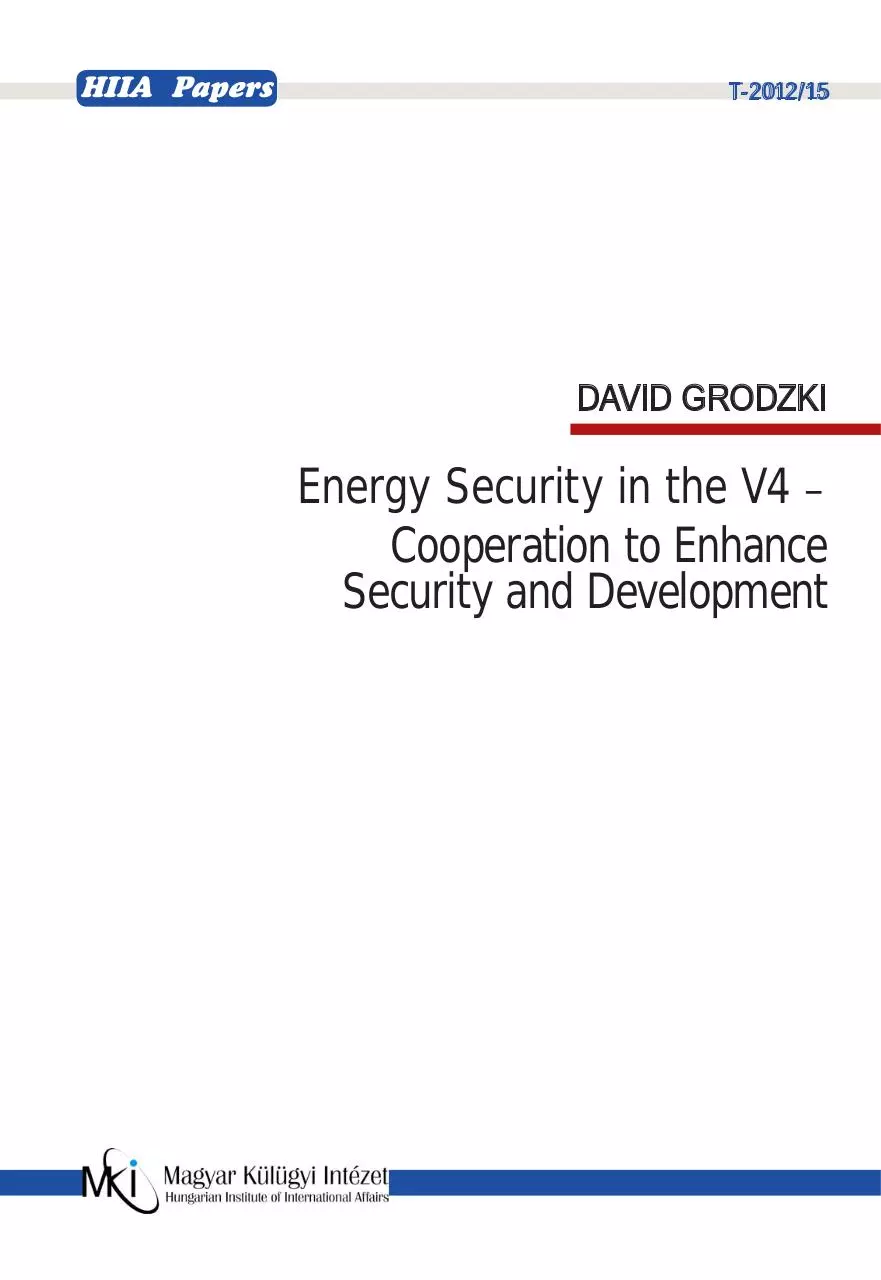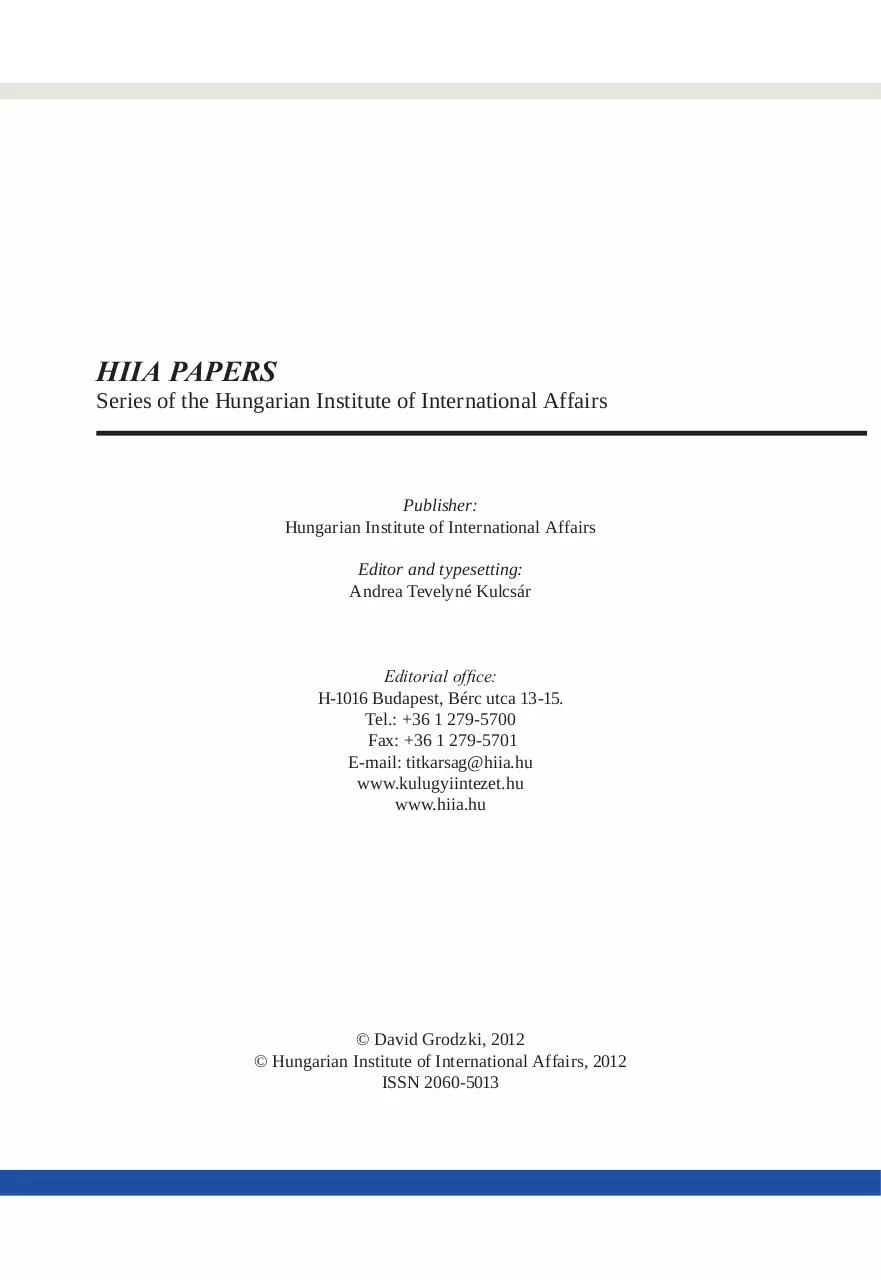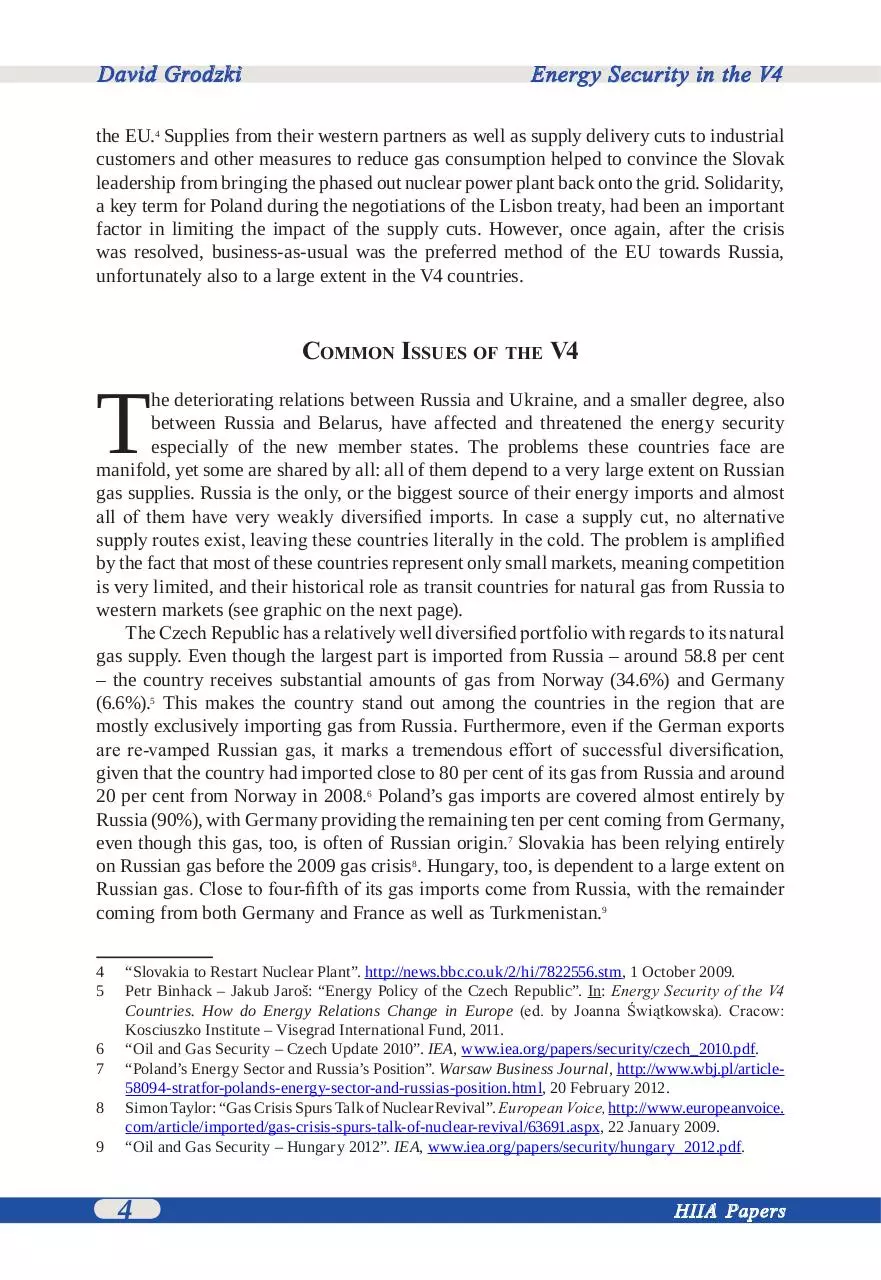David Grodzki Energy Security in the V4 (PDF)
File information
This PDF 1.4 document has been generated by Adobe InDesign CS3 (5.0.4) / Adobe PDF Library 8.0, and has been sent on pdf-archive.com on 27/09/2017 at 14:13, from IP address 185.212.x.x.
The current document download page has been viewed 560 times.
File size: 1.18 MB (20 pages).
Privacy: public file





File preview
HIIA Papers
T-2012 /15
david grodzki
Energy Security in the V4 –
Cooperation to Enhance
Security and Development
HIIA PAPERS
Series of the Hungarian Institute of International Affairs
Publisher:
Hungarian Institute of International Affairs
Editor and typesetting:
Andrea Tevelyné Kulcsár
Editorial office:
H-1016 Budapest, Bérc utca 13-15.
Tel.: +36 1 279-5700
Fax: +36 1 279-5701
E-mail: titkarsag@hiia.hu
www.kulugyiintezet.hu
www.hiia.hu
© David Grodzki, 2012
© Hungarian Institute of International Affairs, 2012
ISSN 2060-5013
Energy Security in the V4
David Grodzki
Introduction
E
nergy security has become one of the most important issues on the agenda of the
European Union since the second gas crisis of 2009 when Russian gas flows to
Europe were interrupted in the course of Moscow’s dispute with Ukraine over
transit fees and higher gas prices. Even though energy security is of importance for
the EU as a whole, with the Commission estimating that the import dependency of the
Union will reach 73-79 per cent by 2020 and close to 90 per cent by 2030, especially the
new twelve member states will be affected by any decision Russia makes about future
(oil1 and) gas exports. In particular the Visegrad countries face a number of common
challenges that make cooperation within the V4 setting not necessarily obligatory but
highly recommendable.
The gas crisis of 2006 when Russian gas supplies dried up for a couple of days and
Central Eastern European (CEE) states were forced to rely on their stocks was only a
precursor to the events of 2009. In 2006 three of the V4 countries reported significant
reductions in supplies. Whereas Hungary faced a severe drop in gas supplies of around 40
per cent, Slovakia received 30 per cent less gas than contractually agreed upon. Poland’s
gas supplies were around 14 per cent lower, compared to normal supply levels.2 The
dispute lasted four days, but alarmed the EU only shortly when the deficiency in supply
was approaching the German and French borders threatening with a wider impact on
EU member states’ supplies. Measures to strengthen the energy security of the EU and
especially of the CEE countries were discussed and dropped shortly thereafter, especially
because the EU’s biggest member states, such as Germany and Italy, remained reluctant to
embrace any measures that would have created a more united European position towards
energy producers like Russia.
How dangerous a lack of a common front vis-á-vis Russia could be was witnessed
three years later, when supplies dried up again. The gas dispute between Ukraine and
Russia in 2009 was more severe in scope, length and consequences, especially for the
V4 countries and their eastern neighbours, Romania and Bulgaria. Supply cuts affected
Hungary, Poland, Slovakia and the Czech Republic so severely that Slovakia declared the
state of emergency.3 The country, which depends almost entirely on Russia for its natural
gas supply even considered restarting a nuclear facility shut down before its accession to
1
2
3
Note that the security of supply with regards to oil is not covered in this paper due to the fact that oil
is a globally traded good with relatively stable costs, regardless of its origin. This allows even the V4
countries to diversify their imports away from Russia to some degree. Nonetheless one should not
assume that the situation is significantly better but interconnection is somewhat better and ensures a
relatively stable supply of this commodity.
“Ukraine ‘Stealing Europe’s Gas’”. http://news.bbc.co.uk/2/hi/europe/4574630.stm, 1 February
2006.
“FACTBOX – 18 Countries Affected by Russia–Ukraine Gas Row”. Reuters, http://www.reuters.
com/article/2009/01/07/uk-russia-ukraine-gas-factbox-idUKTRE5062Q520090107?sp=true, 1 July
2009.
18 July 2012
3
David Grodzki
Energy Security in the V4
the EU.4 Supplies from their western partners as well as supply delivery cuts to industrial
customers and other measures to reduce gas consumption helped to convince the Slovak
leadership from bringing the phased out nuclear power plant back onto the grid. Solidarity,
a key term for Poland during the negotiations of the Lisbon treaty, had been an important
factor in limiting the impact of the supply cuts. However, once again, after the crisis
was resolved, business-as-usual was the preferred method of the EU towards Russia,
unfortunately also to a large extent in the V4 countries.
Common Issues of the V4
T
he deteriorating relations between Russia and Ukraine, and a smaller degree, also
between Russia and Belarus, have affected and threatened the energy security
especially of the new member states. The problems these countries face are
manifold, yet some are shared by all: all of them depend to a very large extent on Russian
gas supplies. Russia is the only, or the biggest source of their energy imports and almost
all of them have very weakly diversified imports. In case a supply cut, no alternative
supply routes exist, leaving these countries literally in the cold. The problem is amplified
by the fact that most of these countries represent only small markets, meaning competition
is very limited, and their historical role as transit countries for natural gas from Russia to
western markets (see graphic on the next page).
The Czech Republic has a relatively well diversified portfolio with regards to its natural
gas supply. Even though the largest part is imported from Russia – around 58.8 per cent
– the country receives substantial amounts of gas from Norway (34.6%) and Germany
(6.6%).5 This makes the country stand out among the countries in the region that are
mostly exclusively importing gas from Russia. Furthermore, even if the German exports
are re-vamped Russian gas, it marks a tremendous effort of successful diversification,
given that the country had imported close to 80 per cent of its gas from Russia and around
20 per cent from Norway in 2008.6 Poland’s gas imports are covered almost entirely by
Russia (90%), with Germany providing the remaining ten per cent coming from Germany,
even though this gas, too, is often of Russian origin.7 Slovakia has been relying entirely
on Russian gas before the 2009 gas crisis8. Hungary, too, is dependent to a large extent on
Russian gas. Close to four-fifth of its gas imports come from Russia, with the remainder
coming from both Germany and France as well as Turkmenistan.9
4
5
6
7
8
9
“Slovakia to Restart Nuclear Plant”. http://news.bbc.co.uk/2/hi/7822556.stm, 1 October 2009.
Petr Binhack – Jakub Jaroš: “Energy Policy of the Czech Republic”. In: Energy Security of the V4
Countries. How do Energy Relations Change in Europe (ed. by Joanna Świątkowska). Cracow:
Kosciuszko Institute – Visegrad International Fund, 2011.
“Oil and Gas Security – Czech Update 2010”. IEA, www.iea.org/papers/security/czech_2010.pdf.
“Poland’s Energy Sector and Russia’s Position”. Warsaw Business Journal, http://www.wbj.pl/article58094-stratfor-polands-energy-sector-and-russias-position.html, 20 February 2012.
Simon Taylor: “Gas Crisis Spurs Talk of Nuclear Revival”. European Voice, http://www.europeanvoice.
com/article/imported/gas-crisis-spurs-talk-of-nuclear-revival/63691.aspx, 22 January 2009.
“Oil and Gas Security – Hungary 2012”. IEA, www.iea.org/papers/security/hungary_2012.pdf.
4
HIIA Papers
David Grodzki
Energy Security in the V4
EIA: Russian natural gas pipelines.
Another feature that currently sets the Czech gas market apart from its partners in
the V4 framework (and also the extended V4+10) is interconnection. It is relatively well
integrated into the European gas market. Interconnectors exist between the Czech network
and Germany, allowing the country to tab into the new Nord Stream pipelines through
the OPAL (Ostsee-Pipeline-Anbindungs-leitung – Baltic Sea Pipeline Link) and Gazelle
pipelines. OPAL will allow Russian gas delivered through Nord Stream to flow to the
Czech Republic – one reason why the country did not join sides with Poland and the
Baltic States in the immediate aftermath after the project was announced. Furthermore,
10 The term V4+ in this paper entails the original V4 countries as well as Bulgaria and Romania. It
should not be confused with the Visegrad+ programme of the V4 group.
18 July 2012
5
David Grodzki
Energy Security in the V4
an interconnector in Cieszyn links the country to the Polish gas networks since late 2011.11
Both connections will add to the already now somewhat secure natural gas supply situation
of the country. However, the gas infrastructure of the Soviet Union and its east–west
orientation currently limit even the Czech Republic’s possibilities to diversify. Any effort
to acquire additional natural gas supplies from the Caspian region, such as energy rich
Turkmenistan, is currently dependent on flow through the Russian pipeline system.
Poland, the biggest of the V4 countries, similarly suffers from the historical east–
west orientation of the Russian pipeline system, which leaves the country in the position
of a transit country for gas destined for Western European markets, such as Germany
or France. Unlike the Czech Republic, Poland has not undertaken serious measures
to diversify its imports before the 2009 gas crisis. This is partly due to the fact that
natural gas plays a smaller role in the country’s energy mix than, for example, in
Hungary. However, the events of 2006–2009 and the Russo-German go alone approach
with Nord Stream, against the objections brought forward by Poland, the Baltic States
as well as Sweden and Finland, have given the government enough stimulus to push
ahead with plans to build an LNG (Liquefied natural gas) terminal in Świnoujście.
Furthermore, interconnectors link the Polish gas network to Germany (at Lasów) and
the Czech Republic (at Cieszyn). Another interconnectors are planned and will
connect Poland and Lithuania. This will allow a future linking between the Baltic
Energy Market12 – the Baltic States, Finland, Sweden, Poland and Germany – with
the V4 energy markets. Just recently intentions to link the gas networks of Poland and
Slovakia have been announced. Such an interconnector would mark a first step towards
the creation of the EU’s Southern Gas Corridor.13 However, so far only an agreement to
conduct a feasibility study has been signed, meaning any real interconnection between
both countries will take a few years before becoming a reality.14
Hungary finds itself in a particularly paradoxical situation. Even though the country
is relatively well interconnected, with interconnectors linking the Hungarian gas network
to Austria (since the mid-1990s), Ukraine and Romania, it is very sensitive to supply
cuts. Around 40 per cent of its primary energy supply is covered by natural gas,15 a figure
that is expected to rise even more till 2030. The majority is imported from Russia and
Turkmenistan. Russian gas amounts to around 80 per cent of Hungary’s natural gas imports,
with Turkmen gas making up a large part of the remainder. The negligible rest of its gas
11 “Polish–Czech Interconnector Launched”. Natural Gas Europe, http://www.naturalgaseurope.com/
polishczech-interconnector-launched, 14 September 2011.
12 “Baltic Energy Market Interconnection Plan (BEMIP)”. European Commission, http://ec.europa.eu/
energy/infrastructure/bemip_en.htm.
13 “Polish, Slovak Companies Choose Contractor for Feasibility Study of Natural Gas Interconnector”.
Natural Gas Europe, http://www.naturalgaseurope.com/gazoprojekt-eurstream-gazsystem-slovakpolish-pipeline, 3 April 2012.
14 “Polish GAZOPROJEKT Becomes Contractor for Interconnector Enabling Country to Access Southern
Gas Corridor”. Turkish Weekly, http://www.turkishweekly.net/news/133281/polish-gazoprojektbecomes-contractor-for-interconnector-enabling-country-to-access-southern-gas-corridor.html, 3
April 2012.
15 Kornel Andzsans-Balogh: “The Road to Hungarian Energy Security”. http://www.ensec.org/index.
php?option=com_content&view=article&id=278:the-road-to-hungarian-energy-security&catid=114:
content0211&Itemid=374, 15 March 2011.
6
HIIA Papers
David Grodzki
Energy Security in the V4
imports come from Germany and France. Even though the addition of Turkmenistan as
a natural gas supplier is good news, the reality is less bright. Turkmen gas is transported
through the Russian pipelines, effectively nullifying the diversification efforts.16 However,
the government has recognised the short-comings of its diversification efforts and new
interconnection with Slovakia, Slovenia as well as Croatia are planned and will allow
Hungary access to natural gas delivered with LNG ships to the LNG terminals in Croatia
and Italy.
Slovakia has been hit hardest among the V4 countries during the 2009 gas crisis. The
country lacks proper linkage to the western markets. Only one interconnector currently
connects the Slovak gas network to Austria. Other interconnections include links with
the Hungarian and the Czech network, both of which were affected by the crisis, too.
Given the country’s dependence on Russia for almost 75% of its natural gas imports
– the remainder is provided by E.ON and GDF Suez17 – diversification efforts have been
relatively modest. Two proposed projects, the Norwegian–Polish interconnector and an
inter-system connector that would have preceded the Norwegian–Polish project, had
received little to no attention from the Slovak government.18
Besides weak diversification and a strong dependence on Russia for natural gas supplies,
another important factor unites the V4 countries: the size of their energy markets. Taken
individually, none of the V4 countries can rival the natural gas consumption volumes of
their Western European partners. Germany’s natural gas consumption, the second highest
in the EU behind the UK, is more than eight times higher than Hungary’s, and still more
than five times higher than Poland’s.19 This has serious implications for the energy security
of these countries as it negatively impacts on the competition on the domestic energy
markets. Whereas in Germany the number of retailers selling natural gas to customers
has reached 820 in 2009, and in Italy stands at 303, the respective figures are considerably
smaller in Poland (52), Slovakia (14), Hungary (28) and the Czech Republic (28).20
Similarly, the market share of the largest natural gas retailers, indicates that the
domestic natural gas markets are usually heavily dominated by one company. Hungary’s
natural gas market is the exception here, as the largest natural gas retailer holds a share
of slightly more than 15 per cent of the market. In the Czech Republic, the market leading
natural gas distributor has a market share of 62.4 per cent. The Slovak market is even
stronger dominated. Here 76 per cent of the natural gas market share is held by the largest
natural gas retailer. In Poland, practically no competition on the natural gas market can
16 “Oil and Gas Security – Hungary 2012”.
17 “SPP Enters into Diversification Contracts with E.ON Ruhrgas and GDF SUEZ”. SPP, http://www.
spp.sk/en/the-media/news/press-releases/?sprava=380. 26 June 2009.
18 Andrej Nosko – Peter Ševce: “The Evolution of Energy Security in the Slovak Republic”. IAGS, http://
www.ensec.org/index.php?option=com_content&view=article&id=262:the-evolution-of-energysecurity-in-the-slovak-republic&catid=110:energysecuritycontent&Itemid=366, 29 September 2010.
19 “Statistical Review of World Energy”. BP, www.bp.com/assets/bp_internet/globalbp/globalbp_
uk_english/reports_and_publications/statistical_energy_review_2011/STAGING/local_assets/pdf/
statistical_review_of_world_energy_full_report_2011.pdf, June 2011.
20 “Natural Gas Market Indicators”. European Commission, http://epp.eurostat.ec.europa.eu/
statistics_explained/index.php/ Natural_ gas_market_indicators#Natural_ gas_market_-_
Import_.26_Production_.28IMPRO.29.
18 July 2012
7
David Grodzki
Energy Security in the V4
be detected. PGNiG has a market share of well over 90 per cent, giving it virtually a
monopoly over imports and distribution of the fuel.21 These numbers are not surprising
when the number of “main” natural gas retailers, e.g. companies that have a share of at least
5 per cent of final customer consumption of natural gas, is taken into account. The Polish
(1), Czech (2) and Slovak (3) natural gas markets have a very low penetration of “main”
natural gas distributors, whereas the Hungarian market is splintered. Ten companies
currently hold a share of at least 5 per cent of total gas consumed. Two reverse trends are
visible in the V4. Whereas the number of main retailers of natural gas has dropped in the
Czech Republic (peak: 8 in 2008) and Poland (7 in 2006), the opposite can be observed
in Hungary where the competition among “main” retailers has increased from 6 (2008) to
10, and Slovakia (from 1 to 3).22 However, drawing the conclusion that a higher number
of “main” companies on the domestic natural gas market translates into more energy
security and more stable supplies of energy would be short-sighted. The respective figures
for two of the EU’s largest natural gas consumers, France (3) and Germany (2) make it
clear that diversification of supplies and supply routes might be more important that the
number of market players.
The lack of competition between energy companies, Hungary excluded, leads to
the unfortunate situation that energy import infrastructure, as well as storage facilities,
remain limited, whereas investments in alternative supply routes are non-existent. These
problems are present in all four Visegrad countries, and efforts to invite other European
energy companies to enter their national markets have been unsuccessful. There is no
doubt that national governments have been reluctant to embrace more competition that
might threaten the position of the often still partly state-owned energy utilities. The Polish
government’s strategy paper on energy policy till 2030 foresees that the government should
introduce measures to strengthen the competition on the energy market, yet maintain
strategic shares in key companies of the sector.23 Among those considered to be a key
asset are oil companies PGNiG, PKN Orlen and Lotos Group. The latter had become a
potential take-over candidate for Russia’s Rosneft, which backed by the Kremlin eagerly
expressed interests in acquiring stakes in Poland’s second largest oil company.24 However,
after an unsuccessful effort to privatise the company – only Russian companies expressed
their intention to bid – plans to privatise Lotos Group were called off in December 2011.
In early 2012 the Polish government announced that no further tender would be opened
to immediately sell its stakes in the company, nor were there any plans for the 2012–13
period.25 Given the lack of interest of western companies in Lotos, the government might
follow through on its plans to keep stakes in key market players. Even though it currently
holds more than 50 per cent in Lotos Group, it might opt for a domestic privatisation of
the company. This idea, though only hinted at, would allow the government to cash in
21 Ibid.
22 Ibid.
23 “Polityka energetyczna do roku 2030” [Energy Policy until 2030]. Ministerstvo Gospodarki, www.
mg.gov.pl/files/upload/8134/Polityka%20energetyczna%20ost_en.pdf, 10 November 2009.
24 Vladimir Socor: “Russia Targeting Oil Assets in Poland and Lithuania”. http://eurodialogue.org/
Russia-Targeting-Oil-Assets-in-Poland-and-Lithuania, 8 November 2010.
25 Jan Cienski: “Lotos: No Russian Buyers, We Are Polish”. http://blogs.ft.com/beyond-brics/2012/03/02/
no-russian-buyers-for-lotos-please-we-are-polish, 12 March 2012.
8
HIIA Papers
David Grodzki
Energy Security in the V4
while keeping the company’s ownership Polish.26 It would not be the first case of domestic
privatisation either. Poland’s cooper mining giant KGHM had increased its share in
Poland’s second largest energy utility Tauron to over 10 per cent in 2010 and announced
recently that it would seek to increase its stake in the company in a move to diversify
revenue streams.27
Concerns especially in the V4 countries over Russian energy companies buying into the
national energy markets are wide-spread. The experience of MOL, the Hungarian energy
utility, which saw more than 20 per cent of its share transferred from Austria’s OMV to
the secretive Russian Surgutneftegaz in 2009, has been a warning to the governments in
Warsaw, Prague and Bratislava. OMV’s failed hostile takeover and subsequent sale to
Surgut had strained relations between Moscow and Budapest as well as between Austria
and Hungary, with the Hungarian government denouncing Austria has having acted in the
interests of Russia and against the EU’s new members. The deal, which held potentially
serious ramifications for Hungary and Central Eastern Europe, was a joint effort of OMV
and Surgut, involving plans that would have seen the Austrian company later purchase the
MOL-owned Slovnaft refinery in Bratislava from the Russians. Furthermore it was a clear
indicator that the Austrian government was not the least interested in the consequences
this agreement would have for its fellow EU partner. MOL, which is considered one of
the most efficient refiners in Central Eastern Europe already received most of its oil from
Surgut, but the acquisition of a fifth of its share would have allowed Surgut and Russia
to exert considerable pressure on the company and Hungary.28 The Austrian government
seemingly did not consult with Budapest in this matter. The government of Prime Minister
Viktor Orbán, fearing a creeping take-over of the country’s energy sector through further
Russian investments, eventually decided to buy out the stakes Surgut had acquired two
years earlier, paying almost two billion Euros.29 To finance the deal the government had
to use previously untapped funds from the 2008 IMF bailout package.
26 Jan Cienski: “Poland Selling Assets to Itself”. http://blogs.ft.com/beyond-brics/2012/02/07/polandselling-assets-to-itself/, 7 February 2012.
27 “Poland Has No Plans to Sell Tauron Control to KGHM-Source”. http://af.reuters.com/article/
metalsNews/idAFL6E8FJ3RQ20120419, 19 April 2012.
28 Vladimir Socor: “Austrian OMV Helped Russian Surgut Launch Takeover Attempt against
Hungarian MOL”. The Jamestown Foundation, http://www.jamestown.org/single/?no_cache=1&tx_
ttnews%5Btt_news%5D=37376, 18 January 2011.
29 Guy Chazan: “Hungary Buys Stake in Oil Company”. The Wall Street Journal, http://online.wsj.com/
article/SB10001424052702303654804576343530886058382.html, 25 May 2011.
18 July 2012
9
Download David Grodzki Energy Security in the V4
David Grodzki_Energy_Security_in_the_V4_.pdf (PDF, 1.18 MB)
Download PDF
Share this file on social networks
Link to this page
Permanent link
Use the permanent link to the download page to share your document on Facebook, Twitter, LinkedIn, or directly with a contact by e-Mail, Messenger, Whatsapp, Line..
Short link
Use the short link to share your document on Twitter or by text message (SMS)
HTML Code
Copy the following HTML code to share your document on a Website or Blog
QR Code to this page

This file has been shared publicly by a user of PDF Archive.
Document ID: 0000678652.